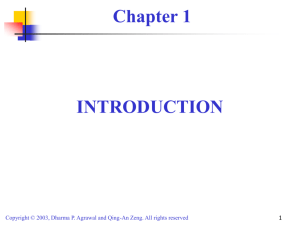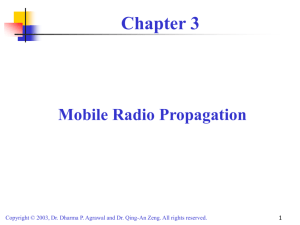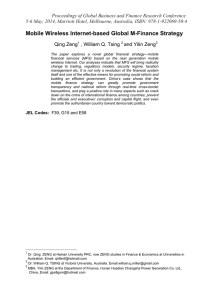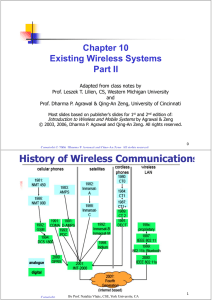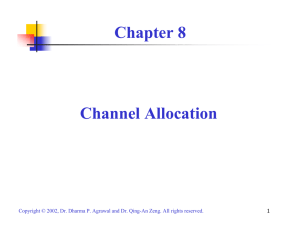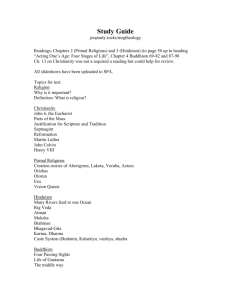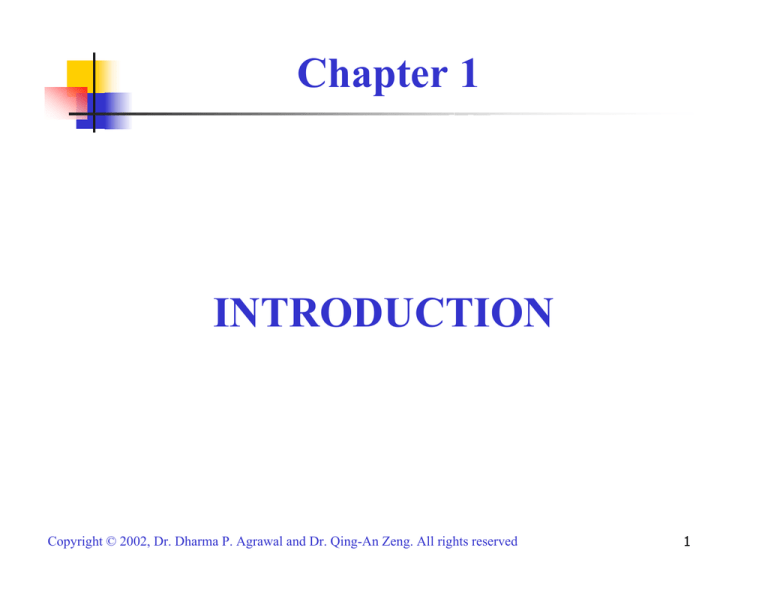
Chapter 1
INTRODUCTION
Copyright © 2002, Dr. Dharma P. Agrawal and Dr. Qing-An Zeng. All rights reserved
1
The History of Mobile Radio Communication (1/3)
1880: Hertz – Initial demonstration of practical radio communication
1897: Marconi – Radio transmission to a tugboat over an 18 mi path
1921: Detroit Police Department: -- Police car radio dispatch (2 MHz
frequency band)
1933: FCC (Federal Communications Commission) – Authorized four
channels in the 30 to 40 MHz range
1938: FCC – Ruled for regular service
1946: Bell Telephone Laboratories – 152 MHz (Simplex)
1956: FCC – 450 MHz (Simplex)
1959: Bell Telephone Laboratories – Suggested 32 MHz band for high
capacity mobile radio communication
1964: FCC – 152 MHz (Full Duplex)
1964: Bell Telephone Laboratories – Active research at 800 MHz
1969: FCC – 450 MHz (Full Duplex)
1974: FCC – 40 MHz bandwidth allocation in the 800 to 900 MHz range
1981: FCC – Release of cellular land mobile phone service in the 40 MHz
bandwidth in the 800 to 900 MHz range for commercial operation
Copyright © 2002, Dr. Dharma P. Agrawal and Dr. Qing-An Zeng. All rights reserved
2
The History of Mobile Radio Communication (2/3)
1981: AT&T and RCC (Radio Common Carrier) reach an agreement to
split 40 MHz spectrum into two 20 MHz bands. Band A belongs to
nonwireline operators (RCC), and Band B belongs to wireline
operators (telephone companies). Each market has two operators.
1982: AT&T is divested, and seven RBOCs (Regional Bell Operating
Companies) are formed to manage the cellular operations
1982: MFJ (Modified Final Judgment) is issued by the government DOJ.
All the operators were prohibited to (1) operate long-distance
business, (2) provide information services, and (3) do
manufacturing business
1983: Ameritech system in operation in Chicago
1984: Most RBOC markets in operation
1986: FCC allocates 5 MHz in extended band
1987: FCC makes lottery on the small MSA and all RSA licenses
1988: TDMA (Time Division Multiple Access) voted as a digital cellular
standard in North America
1992: GSM (Groupe Speciale Mobile) operable in Germany D2 system
Copyright © 2002, Dr. Dharma P. Agrawal and Dr. Qing-An Zeng. All rights reserved
3
The History of Mobile Radio Communication (3/3)
1993: CDMA (Code Division Multiple Access) voted as another digital
cellular standard in North America
1994: American TDMA operable in Seattle, Washington
1994: PDC (Personal Digital Cellular) operable in Tokyo, Japan
1994: Two of six broadband PCS (Personal Communication Service) license
bands in auction
1995: CDMA operable in Hong Kong
1996: US Congress passes Telecommunication Reform Act Bill
1996: The auction money for six broadband PCS licensed bands (120 MHz)
almost reaches 20 billion US dollars
1997: Broadband CDMA considered as one of the third generation mobile
communication technologies for UMTS (Universal Mobile
Telecommunication Systems) during the UMTS workshop conference
held in Korea
1999: ITU (International Telecommunication Union) decides the next
generation mobile communication systems
(e.g., W-CDMA, cdma2000, etc)
Copyright © 2002, Dr. Dharma P. Agrawal and Dr. Qing-An Zeng. All rights reserved
4
Applications
Washington, DC
Cincinnati, OH
Maintaining the telephone number across geographical areas in a
wireless and mobile system
Copyright © 2002, Dr. Dharma P. Agrawal and Dr. Qing-An Zeng. All rights reserved
5
First Generation Cellular Systems and Services
1970s
Developments of radio and computer technologies for 800/900
MHz mobile communications
1976
WARC (World Administrative Radio Conference) allocates
spectrum for cellular radio
1979
NTT (Nippon Telephone & Telegraph) introduces the first
cellular system in Japan
1981
NMT (Nordic Mobile Telephone) 900 system introduced by
Ericsson Radio System AB and deployed in Scandinavia
1984
AMPS (Advanced Mobile Phone Service) introduced by AT&T
in North America
Copyright © 2002, Dr. Dharma P. Agrawal and Dr. Qing-An Zeng. All rights reserved
6
Second Generation Cellular Systems and Services
1982
CEPT (Conference Europeenne des Post et Telecommunications) established GSM
to define future Pan-European cellular Radio Standards
1990
Interim Standard IS-54 (USDC) adopted by TIA (Telecommunications Industry
Association)
1990
Interim Standard IS-19B (NAMPS) adopted by TIA
1991
Japanese PDC (Personal Digital Cellular) system standardized by the MPT
(Ministry of Posts and Telecommunications)
1992
Phase I GSM system is operational
1993
Interim Standard IS-95 (CDMA) adopted by TIA
1994
Interim Standard IS-136 adopted by TIA
1995
PCS Licenses issued in North America
1996
Phase II GSM operational
1997
North American PCS deploys GSM, IS-54, IS-95
1999
IS-54: North America
IS-95: North America, Hong Kong, Israel, Japan, China, etc
GSM: 110 countries
Copyright © 2002, Dr. Dharma P. Agrawal and Dr. Qing-An Zeng. All rights reserved
7
Third Generation Cellular Systems and Services (1/2)
IMT-2000 (International Mobile Telecommunications-2000):
- Fulfill one's dream of anywhere, anytime communications a reality.
Key Features of IMT-2000 include:
- High degree of commonality of design worldwide;
- Compatibility of services within IMT-2000 and with the fixed networks;
- High quality;
- Small terminal for worldwide use;
- Worldwide roaming capability;
- Capability for multimedia applications, and a wide range of services
and terminals.
Copyright © 2002, Dr. Dharma P. Agrawal and Dr. Qing-An Zeng. All rights reserved
8
Third Generation Cellular Systems and Services (2/2)
Important Component of IMT-2000 is ability to provide high bearer
rate capabilities:
- 2 Mbps for fixed environment;
- 384 Kbps for indoor/outdoor and pedestrian
environment;
- 144 kbps for vehicular environment.
Standardization Work:
- In processing
Scheduled Service:
- Started in October 2001 in Japan (W-CDMA)
Copyright © 2002, Dr. Dharma P. Agrawal and Dr. Qing-An Zeng. All rights reserved
9
Subscriber Growth
Subscribers
3G Subscribers
2G Digital only Subscribers
1G Analogue only Subscribers
90 991 992 993 994 995 996 997 998 999 000 001 002 003 004 005 006 007 008 009 010
9
1 1 1
1 1 1 1 1 1
1 2 2 2
2 2 2 2 2
2 2 2
Year
Copyright © 2002, Dr. Dharma P. Agrawal and Dr. Qing-An Zeng. All rights reserved
10
Coverage Aspect of Next Generation Mobile
Communication Systems
Satellite
In-Building
Urban
Suburban
Global
Picocell
Microcell
Macrocell Global
Copyright © 2002, Dr. Dharma P. Agrawal and Dr. Qing-An Zeng. All rights reserved
11
Global System for Mobile Communications
Transmission Capacity
Mobility
Vehicular
Pedestrian
Universal Mobile
Broadband radio
Telecommunications
System
Mobile Broadband System
Local Multipoint Distribution System
Satellite Universal Mobile
Telecommunications
System
Broadband Satellite Multimedia
Stationary
0.01
0.1
1
10
100
Data rate (Mb/s)
Transmission capacity as a function of mobility in some radio access systems
Copyright © 2002, Dr. Dharma P. Agrawal and Dr. Qing-An Zeng. All rights reserved
12
Wireless Technology and Associated
Characteristics
Cellular
Wireless LAN/PAN
GPS
Satellite Based GPS
Home Networking
Ad Hoc Networks
Sensor Networks
Bluetooth
Copyright © 2002, Dr. Dharma P. Agrawal and Dr. Qing-An Zeng. All rights reserved
13
Medical Application
ATM
ATMbackbone
backbone
network
network
In hospital
physician
Remote
databases
ATM switch
ATM switch
Wireless remote
consultation
Ambulance
Possibility for remote consulting
(including audio visual communication)
Copyright © 2002, Dr. Dharma P. Agrawal and Dr. Qing-An Zeng. All rights reserved
14
Fundamentals of Cellular Systems
Ideal cell area
(2-10 km radius)
Cell
Alternative
shape of a cell
BS
MS
MS
Hexagonal cell area
used in most models
Illustration of a cell with a mobile station and a base station
Copyright © 2002, Dr. Dharma P. Agrawal and Dr. Qing-An Zeng. All rights reserved
15
FDMA (Frequency Division Multiple Access)
Frequency
User n
…
User 2
User 1
Time
Copyright © 2002, Dr. Dharma P. Agrawal and Dr. Qing-An Zeng. All rights reserved
16
FDMA Bandwidth Structure
1
2
3
4
…
n
Frequency
Total bandwidth
Copyright © 2002, Dr. Dharma P. Agrawal and Dr. Qing-An Zeng. All rights reserved
17
FDMA Channel Allocation
Frequency 1
User 1
User 2
…
User n
Frequency 2
…
Frequency n
Mobile Stations
Base Station
Copyright © 2002, Dr. Dharma P. Agrawal and Dr. Qing-An Zeng. All rights reserved
18
TDMA (Time Division Multiple Access)
…
User n
User 2
User 1
Frequency
Time
Copyright © 2002, Dr. Dharma P. Agrawal and Dr. Qing-An Zeng. All rights reserved
19
TDMA Frame Structure
1
2
3
4
…
n
Time
Frame
Copyright © 2002, Dr. Dharma P. Agrawal and Dr. Qing-An Zeng. All rights reserved
20
TDMA Frame Illustration for Multiple Users
Time 1
…
User 2
User n
Mobile Stations
Time 2
…
User 1
…
Time n
Base Station
Copyright © 2002, Dr. Dharma P. Agrawal and Dr. Qing-An Zeng. All rights reserved
21
CDMA (Code Division Multiple Access)
User 1
...
User 2
User n
Frequency
Time
Code
Copyright © 2002, Dr. Dharma P. Agrawal and Dr. Qing-An Zeng. All rights reserved
22
Transmitted and Received Signals in a
CDMA System
Information bits
Code at
transmitting end
Transmitted signal
Received signal
Code at
receiving end
Decoded signal
at the receiver
Copyright © 2002, Dr. Dharma P. Agrawal and Dr. Qing-An Zeng. All rights reserved
23
Frequency Hopping
Frequency
Frame
Slot
f1
f2
f3
f4
f5
Time
Copyright © 2002, Dr. Dharma P. Agrawal and Dr. Qing-An Zeng. All rights reserved
24
Cellular System Infrastructure
BS
Service area
(Zone)
Early wireless system: Large zone
Copyright © 2002, Dr. Dharma P. Agrawal and Dr. Qing-An Zeng. All rights reserved
25
Cellular System: Small Zone
BS
BS
BS
BS
Service area
BS
BS
BS
Copyright © 2002, Dr. Dharma P. Agrawal and Dr. Qing-An Zeng. All rights reserved
26
MS, BS, BSC, MSC, and PSTN
PSTN
Home phone
…
MSC
BSC
BS MS
…
…
MSC
BSC
BSC
BS MS
MS BS
Copyright © 2002, Dr. Dharma P. Agrawal and Dr. Qing-An Zeng. All rights reserved
…
…
BSC
MS BS
27
Control and Traffic Channels
F
a
w
r
o
r
Re
F
Mobile Station
do
(
d
v
e
ers
orw
ar
Re
w
n
nli
(u
n
pli
do
(
d
v
e
ers
k
k
li
wn
(u
o
)c
nt
o
)c
n
nt
tr
k)
n
pli
k
c
rol
ha
c
l
o
r
a
c
ffi
a
) tr
f
h
e
nn
n
an
ch
c
fic
l
el
n
an
h
el
n
an
el
Base Station
Copyright © 2002, Dr. Dharma P. Agrawal and Dr. Qing-An Zeng. All rights reserved
28
Steps for a Call Setup from MS to BS
BS
MS
1. Need to establish path
2. Frequency/time slot/code assigned
(FDMA/TDMA/CDMA)
3. Control Information Acknowledgement
4. Start communication
Copyright © 2002, Dr. Dharma P. Agrawal and Dr. Qing-An Zeng. All rights reserved
29
Steps for a Call Setup from BS to MS
BS
MS
1. Call for MS # pending
2. Ready to establish a path
3. Use frequency/time slot/code
(FDMA/TDMA/CDMA)
4. Ready for communication
5. Start communication
Copyright © 2002, Dr. Dharma P. Agrawal and Dr. Qing-An Zeng. All rights reserved
30
A Simplified Wireless Communication
System Representation
Antenna
Information to
be transmitted
(Voice/Data)
Coding
Modulator
Transmitter
Carrier
Information
received
(Voice/Data)
Decoding
Demodulator
Antenna
Receiver
Carrier
Copyright © 2002, Dr. Dharma P. Agrawal and Dr. Qing-An Zeng. All rights reserved
31
Satellite Systems
Traditional Applications
Weather satellite
Radio and TV broadcasting
Military satellites
Telecommunication Applications
Global telephone connections
Backbone for global network
GPS
Copyright © 2002, Dr. Dharma P. Agrawal and Dr. Qing-An Zeng. All rights reserved
32
Network Architectures and Protocols
Systematic Signaling Steps for Information
Exchange
Open Systems Interconnections (OSI)
Transmission Control Protocol (TCP)
Internet Protocol (IP)
Internet Protocol Version 4 (IPv4)
Internet Protocol Version 6 (IPv6) – Work in progress
Mobile IP
Copyright © 2002, Dr. Dharma P. Agrawal and Dr. Qing-An Zeng. All rights reserved
33
Ad Hoc Network
Copyright © 2002, Dr. Dharma P. Agrawal and Dr. Qing-An Zeng. All rights reserved
34
Wireless Sensor Networks
Base station
Antenna
Target
Sensor
Copyright © 2002, Dr. Dharma P. Agrawal and Dr. Qing-An Zeng. All rights reserved
35
Wireless LAN and PAN
Wireless Local Area Network (LAN) using the
IEEE 802.11
HiperLAN is a European Standard
Wireless Personal Area Network (PAN)
Bluetooth
HomeRF
Copyright © 2002, Dr. Dharma P. Agrawal and Dr. Qing-An Zeng. All rights reserved
36

